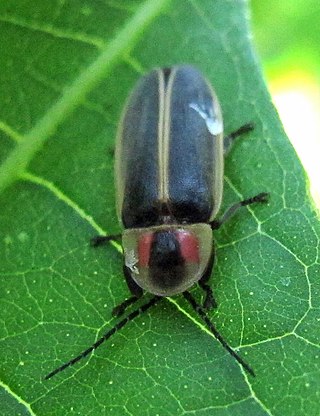Related Research Articles

The Lampyridae are a family of elateroid beetles with more than 2,000 described species, many of which are light-emitting. They are soft-bodied beetles commonly called fireflies, lightning bugs, or glowworms for their conspicuous production of light, mainly during twilight, to attract mates. Light production in the Lampyridae is thought to have originated as an honest warning signal that the larvae were distasteful; this was co-opted as a mating signal in the adults. In a further development, female fireflies of the genus Photuris mimic the flash pattern of Photinus species to trap their males as prey.

The rover fireflies (Photinus) are a genus of fireflies. They are the type genus of tribe Photinini in subfamily Lampyrinae. This genus contains, for example, the common eastern firefly, the most common species of firefly in North America.
Photinus dimissus is a species of firefly in the family Lampyridae. It is found in North America.
Photinus macdermotti, or Father Mac's firefly or Mr. Mac, is a species of firefly in the family Lampyridae. It is found in North America.

Photinus sabulosus is a species of firefly in the beetle family Lampyridae. It is found in North America.
Photinus ardens is a species of firefly in the beetle family Lampyridae. It is found in North America.
Photinus marginellus is a species of firefly in the beetle family Lampyridae. It is found in North America.
Photinus cookii is a species of firefly in the beetle family Lampyridae. It is found in North America in the Eastern USA, including Florida and Texas.
Photinus concisus is a species of firefly in the beetle family Lampyridae. It is found in Kerrville, Texas. It the species most closely related to Photinus pyralis.
Photinus collustrans is a species of firefly in the beetle family Lampyridae. It is found in North America.
Photinus consimilis, or cattail flash-train firefly, is a species of firefly in the beetle family Lampyridae. It is found in eastern North America.
Photinus indictus, or silent firefly, is a species of firefly in the beetle family Lampyridae. It is a diurnal firefly, active during the day rather than at night, with no lanterns. It is found in eastern North America.
Photinus knulli is a species of firefly in the beetle family Lampyridae. It is found in North America.
Photinus tenuicinctus is a species of firefly in the beetle family Lampyridae. It is found in North America.
Photinus punctulatus is a species of firefly in the beetle family Lampyridae. It is found in North America.
Photinus obscurellus is a species of firefly in the family Lampyridae. It is found in North America.
Photinus immaculatus is a species of firefly in the beetle family Lampyridae. It is found in North America.
Photinus texanus is a species of firefly in the beetle family Lampyridae. It is found in North America.

A lucibufagin is a defensive steroid produced by several species of firefly to make them unpalatable to predators such as spiders and birds. Certain species of firefly that do not themselves produce lucibufagins have been observed to eat other species of firefly that do produce the steroid to gain the defensive properties for themselves. The lucibufagins are a set of three related compounds, and are in the same structural class as the bufadienolides.

Photinus signaticollis is a species of firefly native to Argentina and Uruguay. In 2018 the species was observed in the northeast of the Iberian Peninsula, and initially described as a new species, Photinus immigrans. However, in 2022 it was found that the population in the Iberian Peninsula corresponded to the species Photinus signaticollis.
References
- ↑ "Photinus ignitus Report". Integrated Taxonomic Information System. Retrieved 2019-09-23.
- ↑ "Photinus ignitus". GBIF. Retrieved 2019-09-23.
- ↑ "Photinus ignitus species Information". BugGuide.net. Retrieved 2019-09-23.